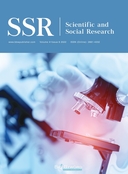Abstract
This paper utilizes the A-B-A-B reversal experimental design for the single-subject research, to study the self-injurious behavior of a sixth-grade student with severe autism, aiming to explore the intervention effect of sports games on the self-injury behavior of children with severe autism. The results showed that, the self-injury behavior such as, the number of times of biting the back of the hands, and picking the noses is reduced in the study subject following sports games intervention plans, however, the self-injurious still exists, especially when the study subject in an unfamiliar environment, further indicating that the self-injurious behavior of children with severe autism cannot be completely eliminated by sports games alone. Concluding that, self-injurious behavior of children with severe autism cannot be completely eliminated by sports games, a comprehensive intervention with multiple approaches is still required to achieve optimal results.
References
Matson JL, Nebel-Schwalm M, 2006, Assessing of Challenging Behaviors in Persons with Autism Spectrum Disorders. Research in Developmental Disabilities. http://doi:10.1016/j.ridd.2006.08.001
Turner MA, 1999, Annotation: Repetitive Behaviour in Autism: A Review of Psychological Research. Journal of Child Psychology and Psychiatry and Allied Disciplines, 40(6): 839-849.
Rojahn J, Schroeder SR, Hoch TA, Self-Injurious Behavior in Intellectual Disabilities. New York: Elsevier: in press.
Dominick KC, Davis NO, Lainhart J, et al., 2007, Atypical Behaviors in Children with Autism and Children with a History of Language Impairment. Research in Developmental Disabilities, 28(2): 145-162.
La-Malfa G, Lassi S, Bertelli M, et al., 2004, Autism and Intel-Lectual Disability: A Study of The Prevalence on a Sample of the Italian Population. Journal of Intellectual Disability Research, 48(3): 262-267.
China Autism Industry Portal: http://www.0zbz.com/article/article_4396.html.
Cui B, 2019, A Case Study on the Effect of Aerobics on the Problem Behavior of Children with Autism. Beijing Sports University.
Zhou L, 2015, A Review of Sports Intervention Research for Children with Autism. Sports World (Academic Edition), 74(09): 133-134.
Du L, 2017, Theoretical Review on the Formation of Self-Injury Behavior in Children with Autism. Education Forum, 4(06): 353.
Abbott AE, Linke AC, Nair A, et al., 2018, Repetitive Behaviors in Autism are Linked to Imbalance of Corticostriatal Connectivity: A Functional Connectivity MRI Study. Social Cognitive and Affective Neuroscience, 13(1): 32-42.
Oliver C, Richards C, 2015, Practitioner Review: Self-Injurious Behavior in Children with Developmental Delay. The Journal of Child Psychology and Psychiatry. http://org.10.1111/jcpp.12425
Andzik N, Cannella-Malone HI, 2017, A Review of the Pyramidal Training Approach for Practitioners Working with Individuals with Disabilities. Behavior Modification, 41(2): 558-580.
Darragh P, Devine, 2019, The Pemoline Model of Self-Injurious Behavior: An Update. Psychiatric Disorderspp, 5(7): 95-103.
Benjamin L, Handen-Carla A, Mazefsky, et al., 2018, Risk Factors for Self-Injurious Behavior in an Inpatient Psychiatric Sample of Children with Autism Spectrum Disorder: A Naturalistic Observation Study. Journal of Autism and Developmental Disorders, 48(1): 3678-3688.
Akhtar N, Jaswal VK, 2019, Stretching the Social: Broadening the Behavioral Indicators of Sociality. Child Dev Perspect, 14(11): 28-33.
Joseph L, Calles Jr, 2019, Psychopharmacology of Autism Spectrum Disorder. Psychiatr Ann, 49(3): 120–124.
Makowska I, Gmitrowicz A, 2018, Non-Suicidal Self-Injury Vs. Suicidal Behaviour Disorder. Journal of Psychiatry of Pshchology and Clinical Psychology, 18(2): 173.
Jaswal VK, Akhtar N, 2018, Being Versus Appearing Socially Interested: Challenging Assumptions About Social Motivation in Autism. Behav Brain Sci, 42(6): 1-14.
Matson JL, Nebel-Schwalm M, 2007, Assessing Challenging Behaviors in Children with Autism Spectrum Disorders: A Review. Res Dev Disability, 28(6): 567-579
Lance EI, York JM, Lee LC, et al., 2014, Association between Regression and Self Injury Among Children with Autism. Research in Developmental Disabilities, 35(2): 408-413.
